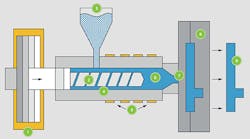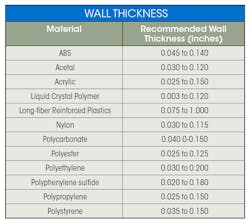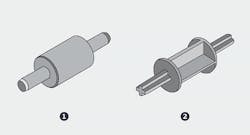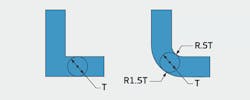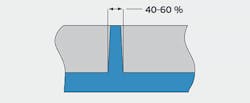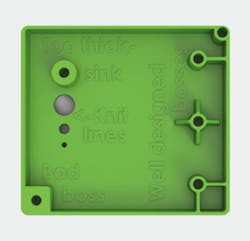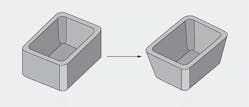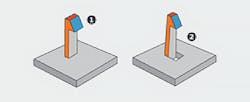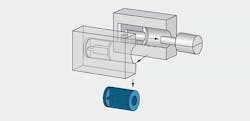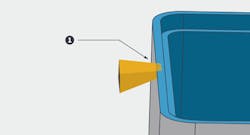Designing plastic parts that can be molded has always been important for traditional injection molding processes, but it’s particularly beneficial for parts about to be rapid injection molded (RIM) to ensure speed and quality remain constant during manufacturing. Here’s a look at many of the critical design considerations encountered during rapid injection molding
Rapid Injection Molding
With RIM, CAD models are sent directly to the production floor where mold milling begins. In most cases, molds are fabricated from aluminum, not steel. This allows for faster and more cost-effective tooling compared to traditional steel molds.
RIM accommodates side-action and hand-load inserts, as well as simple overmolding and insert molding. Selective use of electrical discharge machining (EDM) can improve mold features such as corners and edges. And several surface finish options are available. All of this lets RIM make parts in a few weeks rather than the months needed for traditional injection molding methods.
From left to right, the components of a RIM press include: ram (1), screw (2), hopper (3), barrel (4), heaters (5), materials (6), nozzle (7), mold (8), and part (9).
Here are some common applications for RIM:
- Iterate quickly with rapidly built prototypes
- Test functions during product development with production-grade parts
- Test several different materials
- Test several CAD models
- Implement bridge tooling
- Leverage low-volume production for on-demand parts
- Manage demand volatility
- Get thousands of parts within days
Part Features for RIM
From wall thickness and radii to ramps and ribs, here’s a quick look at factors designers and engineers should consider if parts will be injection molded.
Wall Thickness: The most crucial design requirement for getting good molded parts is to maintain constant wall thickness. They minimize the potential for warped or distorted parts.
Note: These are general guidelines, subject to part geometry and molded construction. Larger parts shouldn’t be designed with the minimum wall thickness. Protolabs’ general rule for wall thickness is 0.040 to 0.140 in.
Core Geometry: Core out parts to eliminate thick walls. You get the same functions in a well molded part. Unnecessary thickness can alter part dimensions, reduce strength, and necessitate post-process machining.
The part on the left is the originally designed part. The part on the right has been cored out to reduce part thickness while still being able to perform all of its necessary functions.
Ramps: Eliminate sharp transitions that cause molded-in stress.
Fillets: Design features that support themselves.
Radii: Sharp corners weaken parts and create molded-in stress from resin flow. Designers should add radii in sharp corners.
Ribs: To prevent sink, ribs should be no more than 60% of the wall’s thickness.
Bosses: Don’t create thick sections with screw bosses since thick sections can cause sink and voids in your part.
The bosses on the left are poor as they are too thick and might not fill completely, leaving voids. The bosses on the right, however, create strength without having sections that are too thick.
Draft: Draft (slope the vertical walls) as much as possible to make it easier to eject parts without drag marks or ejector punch marks. Draft also lets designers make deeper features, plus it reduces tool chatter and cosmetic defects when milling deep walls. If you can fit it in, use 1 deg. of draft or more. On core-cavity designs, use 2 deg. or more. A rough rule of thumb is 1 deg. of draft for each of the first 2 in. of depth. From 2 to 4 in. of depth, either 3 deg. of draft or a minimum of 1/8 in. thickness may be required.
Core-Cavity: When you draft, use core-cavity instead of ribs. It provides constant wall thicknesses rather than walls with a thick base. It also lets machine shops mill molds with better surface finish and deliver better parts faster.
Undercuts: An undercut is an area of the part that shadows another area of the part, creating an interlock between the part and one or both mold halves. On the image below, the left image (1) illustrates a clip with an undercut feature. On the right image (2), an access hole beneath the undercut lets the mold protrude through the part and provides the needed latch shutoff geometry.
Side-Actions: Side-actions form undercuts on the outside of a part. The undercuts must be on or connected to the parting line. They must also be in the plane of the parting line and connected and perpendicular to the direction the mold is opening.
The round blue part is the side a-action.
Bumpoffs: A bumpoff is a small undercut in a part design that can be safely removed from a straight-pull mold without using side-actions. Bumpoffs can solve some simple slight undercuts, but are sensitive to geometry and material.
The green part is the bumpoff.
Pickouts: A pickout is a separate piece of metal inserted into the mold to create an undercut. It is ejected with the part, then removed by the operator and re-inserted in the mold. Using a pickout lets designers overcome shape and positioning restrictions, but is more costly than sliding shutoffs or using a side-action.
Steel Core Pins: These holes can be made with steel core pins in the mold. A steel pin is strong enough to handle the stress of ejection and is smooth enough to release cleanly from the part without draft. There shouldn’t be any cosmetic effect on the resulting part; if there is, it will be inside the hole where it won’t be seen.
Logos and Text: Textured surfaces, molded part numbers, and company logos look good, but be prepared to pay a bit extra for these and other non-mission critical features. That said, permanent part numbers are requirements for many aerospace and military applications. For text, it is recommended designers:
w Use a mill-friendly (san-serif fonts) font such as Century Gothic Bold, Arial, or Verdana.
w Keep the font above 20 pt.
w Don’t go much deeper than 0.010 to 0.015 in.
w Be prepared to increase draft if part ejection is a concern
Tab Gates: Thin edges restrict flow and can break during gate trimming. Tab gates give injection molders a thick area to place a gate into your part. There may be alternatives, so please contact the molder’s applications engineers.
Self-Mating Parts: Identical parts that flip over and mate to themselves are possible and save the cost of a second mold. Elements to let them mate include pegs and holes, interlocking rims, and hooks and latches.
Tolerances: Molders can generally hold about ±0.003 in. machining accuracy. Shrink tolerance depends mainly on part design and resin choice. It varies from 0.002 in./in. for stable resins such as ABS and polycarbonate to 0.025 in./in. for unstable resins such as TPE. There are techniques for getting the most accuracy out of injection molding. Contact an applications engineer at your injection molder for more information.
Material Selection
When choosing a material for a part, relevant properties might include mechanical, physical, chemical resistance, heat, electrical, flammability, and UV resistance. Resin manufacturers, compounders, and independent resin search engines have data online. Here is a quick look at some common commodity and engineering resins.
Commodity Resins
Polypropylene
- Soft
- Tough
- Cheap
- Chemical resistant
- Makes good living hinges
Polyethylene
- Soft
- Tough
- Cheap
- Chemical resistant
- High density
- Low density
Polystyrene
- Hard
- Clear
- Cheap
- Brittle but can be toughened
Engineering Resins
ABS
- Inexpensive
- Impact resistant
- Equipment and handheld housings
- Susceptible to sink
Acetal
- More expensive
- Strong
- Good lubricity and machinability
- Very sensitive to excess wall thickness
LCP
- Very expensive
- Very strong
- Fills very thin parts
- Weak knit lines
Nylon
- Reasonable cost
- Very strong
- Susceptible to shrink and warp, particularly glass-filled
- Absorbs water, which leads to dimensional and property change
Polycarbonate
- Moderate cost
- Very tough
- Good dimensional accuracy
- Susceptible to chemical stress cracking, voids
Other engineering resins include PBT, PET, PPS, PSU, PES, and PEI.
Selecting Colorants: Stock colors from the resin vendor are typically black and natural. Natural might be white, beige, amber, or another color. Semi-custom colors are created when colorant pellets are added to natural resins. For available colors, check with your injection molder. In some cases, such as at Protolabs, there is no added charge for our inventory colors. But they may not be an exact match and may create streaks or swirls in parts. Custom colors that need to match an exact Pantone or color chip need to be compounded with a resin supplier. This process is slower and more expensive, but produces a more accurate match.
Resin Additives
Short glass fibers can be added to a resin to strengthen a composite and reduce creep, especially at higher temperatures. They make the resin stronger, stiffer, and more brittle. They can also cause warp due to the difference in cooling shrink between the resin and fibers.
Long glass fibers are used like short glass fibers to strengthen and reduce creep, but make the resin much stronger and stiffer. The downside is that they can be particularly challenging to mold parts that have thin walls and/or long resin flows.
Aramid (Kevlar) fibers are like less-abrasive glass fibers, only not as strong.
Carbon fiber strengthens and/or stiffens a composite and aids in static dissipation. It has the same limitations as glass fibers. Carbon fiber can make plastic very stiff.
Stainless steel fibers are used to control EMI (electromagnetic interference) and RFI (radio frequency interference) typically in housings for electronic components. They are more conductive than carbon fiber.
Minerals such as talc and clay are often used as fillers to reduce costs or increase the hardness of finished parts. Because they do not shrink as much as resins do when cooled, they can reduce warping.
PTFE (Teflon) and molybdenum disulfide are used to make parts self-lubricating in bearing applications.
Glass beads and mica flakes stiffen a composite and reduce warping and shrinkage. With high loading, they can be challenging to inject.
UV inhibitors prevent parts from breaking down in the sunlight for outdoor applications.
Static treatments make resins dissipate static.
If you have any questions regarding injection molding or rapid injection molding, please feel free to call a Protolabs application engineer at (877) 479-3680 or e-mail [email protected].










